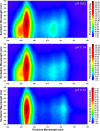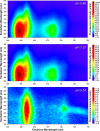A Preliminary Study of the Effects of pH upon Fluorescence in Suspensions of Prevotella intermedia
- PMID: 27441707
- PMCID: PMC4956196
- DOI: 10.1371/journal.pone.0158835
A Preliminary Study of the Effects of pH upon Fluorescence in Suspensions of Prevotella intermedia
Abstract
The quantification of fluorescence in dental plaque is currently being developed as a diagnostic tool to help inform and improve oral health. The oral anaerobe Prevotella intermedia exhibits red fluorescence due to the accumulation of porphyrins. pH affects the fluorescence of abiotic preparations of porphyrins caused by changes in speciation between monomers, higher aggregates and dimers, but this phenomenon has not been demonstrated in bacteria. Fluorescence spectra were obtained from suspensions of P. intermedia that were adjusted to pHs commensurate with the range found within dental plaque. Two fluorescent motifs were identified; 410 nm excitation / 634 nm emission (peak A) and 398 nm excitation / 622 nm emission (peak B). A transition in the fluorescence spectra was observed from peak A to peak B with increasing pH which was also evident as culture age increased from 24 hours to 96 hours. In addition to these 'blue-shifts', the intensity of peak A increased with pH whilst decreasing with culture age from 24 to 96 hours. A bacterium's relationship with the local physiochemical environment at the time of image capture may therefore affect the quantification of dental plaque fluorescence.
Conflict of interest statement
Figures







Similar articles
-
Evaluating the effect of local pH on fluorescence emissions from oral bacteria of the genus Prevotella.J Biomed Opt. 2016 Aug 1;21(8):84003. doi: 10.1117/1.JBO.21.8.084003. J Biomed Opt. 2016. PMID: 27552307
-
Photobleaching of red fluorescence in oral biofilms.J Periodontal Res. 2011 Apr;46(2):228-34. doi: 10.1111/j.1600-0765.2010.01334.x. Epub 2010 Dec 28. J Periodontal Res. 2011. PMID: 21198645
-
In vitro activation of the hemolysin in Prevotella nigrescens ATCC 33563 and Prevotella intermedia ATCC 25611.Res Microbiol. 2004 Jan-Feb;155(1):31-8. doi: 10.1016/j.resmic.2003.09.010. Res Microbiol. 2004. PMID: 14759706
-
[Fluorescence spectra and protonation of ofloxacin].Guang Pu Xue Yu Guang Pu Fen Xi. 2005 Apr;25(4):584-7. Guang Pu Xue Yu Guang Pu Fen Xi. 2005. PMID: 16097692 Chinese.
-
Isolation and characterization of hemolysin activated by reductant from Prevotella intermedia.FEMS Immunol Med Microbiol. 2003 Jan 21;35(1):43-7. doi: 10.1111/j.1574-695X.2003.tb00647.x. FEMS Immunol Med Microbiol. 2003. PMID: 12589956
Cited by
-
A Clearing Technique to Enhance Endogenous Fluorophores in Skin and Soft Tissue.Sci Rep. 2019 Oct 31;9(1):15791. doi: 10.1038/s41598-019-50359-x. Sci Rep. 2019. PMID: 31673001 Free PMC article.
-
Archaeal and bacterial community structures of rural household biogas digesters with different raw materials in Qinghai Plateau.Biotechnol Lett. 2021 Jul;43(7):1337-1348. doi: 10.1007/s10529-021-03105-1. Epub 2021 Apr 3. Biotechnol Lett. 2021. PMID: 33811593
-
Analysis of muscle tissue in vivo using fiber-optic autofluorescence and diffuse reflectance spectroscopy.J Biomed Opt. 2021 Dec;26(12):125001. doi: 10.1117/1.JBO.26.12.125001. J Biomed Opt. 2021. PMID: 34935315 Free PMC article.
-
Autofluorescence properties of wound-associated bacteria cultured under various temperature, salinity, and pH conditions.BMC Microbiol. 2025 Aug 15;25(1):511. doi: 10.1186/s12866-025-04200-3. BMC Microbiol. 2025. PMID: 40817211 Free PMC article.
References
-
- Shah HN, Gharbia SE (1993) Biochemical and chemical analyses of black-pigmented gram-negative anaerobes. FEMS Immunol Med Microbiol 6: 89–96. - PubMed
-
- Smalley JW, Silver J, Birss AJ, Withnall R, Titler PJ (2003) The haem pigment of the oral anaerobes Prevotella nigrescens and Prevotella intermedia is composed of iron(III) protoporphyrin IX in the monomeric form. Microbiology 149: 1711–1718. - PubMed
-
- Marcelli A, Jelovica Badovinac I, Orlic N, Salvi PR, Gellini C (2013) Excited-state absorption and ultrafast relaxation dynamics of protoporphyrin IX and hemin. Photochemical & Photobiological Sciences 12: 348–355. - PubMed
MeSH terms
LinkOut - more resources
Full Text Sources
Other Literature Sources

